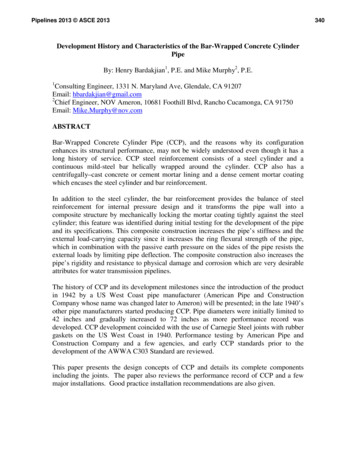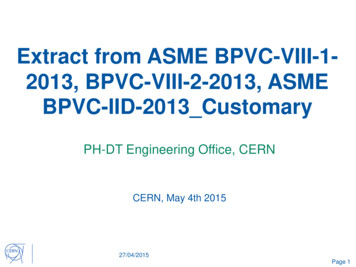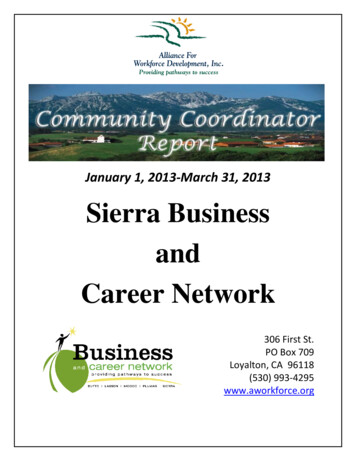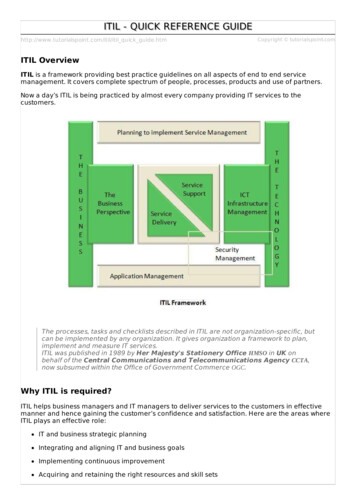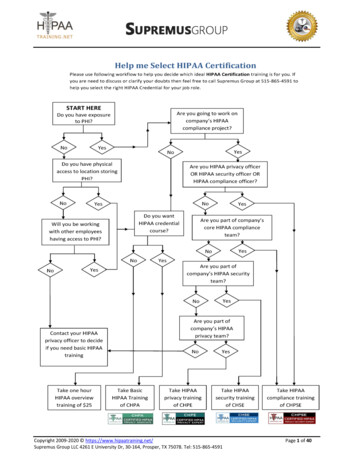
Transcription
Copyright 2013 by the American Association of Colleges of Nursing.All rights reserved. No part of this document may be reproduced in print, orby photostatic means, or in any other manner, without the express writtenpermission of the publisher.1
American Association of Colleges of NursingCompetencies and Curricular Expectationsfor Clinical Nurse LeaderEducation and PracticeSMOctober 20132
CLINICAL NURSE LEADER EXPERT PANELPamela Abraham, MSN, RN, CNLClinical Nurse LeaderHunterdon Medical CenterTammy Lee, MSN, RN, CNLClinical Nurse Leader CoordinatorCarolinas Medical CenterJames Harris, DSN, RN, MBA,APRN-BCProfessor & Director of CNLProgramUniversity of South AlabamaNina Swan, MSN, RN, CMSRN,CNLCNLA LiaisonNurse ManagerMaine Medical CenterMarjorie M. Godfrey, PhD, RNCo-Director, The Dartmouth InstituteMicrosystemAcademy & Instructor,The Dartmouth Institute for HealthPolicy and Clinical PracticeDartmouth Medical SchoolTricia Thomas, PhD, RN, CNLDirector, Nursing Practice &ResearchTrinity HealthNancy Hilton, MN, RNChief Nursing OfficerSt. Lucie Medical CenterLorraine R. Kaack, MS, RN, CNLCNC LiaisonClinical Nurse LeaderBay Pines Veterans Affairs HealthSystemSandra Kuntz, PhD, RNAssociate ProfessorMontana State University- BozemanRita Vann, RNSenior Vice President of HealthcareServicesBrookdale Senior Living, Inc.Joan Stanley, PhD, RN, FAAN,FAANP, staff liaisonSenior Director of Education PolicyKaren S. Kesten, DNP, APRN,CCRN, PCCN, CCNS, CNE, staffliaisonDirector of Educational InnovationsHoracio Oliveira, staff liaisonEducation Policy and SpecialProjects CoordinatorEllen T. Kurtzman, MPH, RN,FAANAssistant Research ProfessorSchool of NursingThe George Washington UniversityCathy Leahy, MSN, MEd, RN, CNLFaculty, School of NursingXavier University3
INTRODUCTIONThe CNL is a master’s educated nurse, prepared for practice across the continuum of carewithin any healthcare setting in today’s changing healthcare environment. This documentdelineates the entry-level competencies for all Clinical Nurse Leaders (CNLs). These CNLcompetencies build on the American Association of Colleges of Nursing (AACN) The Essentialsof Master’s Education in Nursing (2011).AACN, representing baccalaureate and graduate schools of nursing, in collaboration with otherhealthcare organizations and disciplines, first introduced the Clinical Nurse Leader (CNL) in2003, the first new nursing role in over 35 years, to address the ardent call for change being heardin the healthcare system. The competencies deemed necessary for the CNL originally weredelineated by the AACN Task Force on Education & Regulation II (TFERII) in the WorkingPaper on the Clinical Nurse Leader. In 2007, the AACN Board of Directors approved the WhitePaper on the Education and Role of the Clinical Nurse Leader. The White Paper provided thebackground, rationale, and description of the CNL role and education as well as the expectedoutcomes and competencies for all CNL graduates. The background, rationale, and description ofCNL practice as well as the assumptions for preparing the CNL remain particularly relevant;therefore, the White Paper is included as an attachment to this document.The competencies delineated here have been revised and updated to reflect CNL practice withinthe changing healthcare environment. Therefore, these competencies replace the competencies inthe White Paper on the Education and Role of the Clinical Nurse Leader (February, 2007). Inaddition to the CNL master’s level competencies, the Curriculum Framework andClinical/Practice Expectations for CNL programs are included. These components provide thebasis for the design and implementation of a master’s or post-master’s CNL education programand prepare the graduate to sit for the Commission on Nurse Certification (CNC) CNLCertification Examination.CNL PRACTICEThe CNL is a leader in the healthcare delivery system in all settings in which healthcare isdelivered. CNL practice will vary across settings. The CNL is not one of administration ormanagement. The CNL assumes accountability for patient-care outcomes through theassimilation and application of evidence-based information to design, implement, and evaluatepatient-care processes and models of care delivery. The CNL is a provider and manager of care atthe point of care to individuals and cohorts of patients anywhere healthcare is delivered.Fundamental aspects of CNL practice include: Clinical leadership for patient-care practices and delivery, including the design,coordination, and evaluation of care for individuals, families, groups, and populations; Participation in identification and collection of care outcomes; Accountability for evaluation and improvement of point-of-care outcomes, including thesynthesis of data and other evidence to evaluate and achieve optimal outcomes;4
Risk anticipation for individuals and cohorts of patients;Lateral integration of care for individuals and cohorts of patientsDesign and implementation of evidence-based practice(s);Team leadership, management and collaboration with other health professional teammembers;Information management or the use of information systems and technologies to improvehealthcare outcomes;Stewardship and leveraging of human, environmental, and material resources; and,Advocacy for patients, communities, and the health professional team.COMPETENCY DEVELOPMENT PROCESSThe Clinical Nurse Leader Competencies reflect a national consensus-based process. AACNfacilitated the process to develop these consensus-based competencies, including the work of thenational Expert Panel and external Validation Panel, both representing CNL education andpractice. In addition, the Expert Panel included representation from two national stakeholderorganizations: the Commission on Nurse Certification (CNC) and the Clinical Nurse LeaderAssociation (CNLA). The process used for this project models that previously used for thedevelopment of the Nurse Practitioner Primary Care Competencies in Specialty Areas: Adult,Family, Gerontology, Pediatric, and Women’s Health (2002) as well as a number of othernationally recognized nursing competencies.The Expert Panel (see page 3) initially convened in April 2012 first via conference call and thenface-to-face at AACN headquarters in Washington, DC. During this meeting, the panel reviewedrelevant documents including the CNC Job Analysis results, AACN’s The Essentials of Master’sEducation in Nursing (2011), and the White Paper on the Education and Role of the ClinicalNurse Leader (2007). After the face-to-face meeting, the Panel met electronically and byconference call to review and discuss the competencies. By early summer 2013 the panel reachedconsensus on the draft competencies and completed Phase I of the competency developmentprocess. Phase II, the validation process, was conducted in July and August 2013.A letter of invitation to participate in the validation process was sent to 150 individuals,randomly selected from the CNL database. Invited individuals equally represented CNLeducation (including faculty, program directors, and deans) and practice (including chief nursingofficers/nurse managers and practicing CNLs). Sixty-three individuals accepted the invitationand participated in the validation review process. The Validation Panel representation includedCNOs, CNLs, faculty, and deans. Distribution and representation on the Validation Panel isshown in Figure 1. The validation tool developed originally as part of the Health Resource andServices Administration (HRSA) funded nurse practitioner primary care competencies project(2002) was adapted to a SurveyMonkey online format. The Validation Panel was asked tosystematically review each CNL competency for relevance (i.e., is the competency necessary?)and specificity (i.e., is the competency stated specifically and clearly? If not, provide suggestedrevisions.) The Validation Panel also was asked to provide comment on the comprehensivenessof the competencies.5
The validation process demonstrated overwhelming consensus with the competencies andprovided valuable feedback for additional refinement. The Expert Panel met electronically fourtimes subsequent to this process to review the validation results, revise the competencies asneeded, and produce the final set of 82 competencies delineated in this document. Based on thefeedback from the Validation Panel, 14 competencies were deleted, one competency was added,and 50 (61%) of the competencies underwent revision to enhance specificity or clarity. TheExpert Panel also reviewed Validation Panel responses regarding required clinical expectationsfor CNL education programs and made final recommendations.Figure 1: Validation Panel CompositionCNL CURRICULUMThe master’s nursing curriculum is conceptualized in Figure 1 and includes three components(AACN, 2011, p. 7-8):1. Graduate Nursing Core: foundational curriculum content deemed essential for allstudents who pursue a master’s degree in nursing regardless of the functional focus.2. Direct Care Core: essential content to provide direct patient services at an advancedlevel.3. Functional Area Content: those clinical and didactic learning experiences identifiedand defined by the professional nursing organizations and certification bodies forspecific nursing roles or functions [CNL competencies and clinical expectations].6
*All master’s degree programs that prepare graduates for roles that have a component ofdirect care practice that includes the CNL are required to have graduate levelcontent/coursework in the following three areas: physiology/pathophysiology, healthassessment, and pharmacology. [Although not required, it is recommended that the CNLcurriculum include three separate graduate-level courses in these three content areas.Having CNLs at the point of care with a strong background in these three areas is seen asimperative from the practice perspective. In addition, the inclusion of these three separatecourses facilitates the transition of these master’s program graduates into DNP direct care(advanced practice registered nurse) programs.] The competencies for the CNL role are delineated in this document.Therefore, the three components comprising the master’s-level CNL curriculum include: Master’s Graduate Nursing Core: The outcomes delineated in The Essentials of Master’sEducation in Nursing. Direct Care Core: Graduate level content/coursework in physiology/pathophysiology,health assessment, and pharmacology. CNL Role Competencies & Clinical Expectations: Delineated in this document.7
These three components reflect the current knowledge base and scope of practice for entry-levelCNLs. As scientific knowledge expands and the healthcare system and practice evolve inresponse to societal needs, CNL competencies and practice also will evolve. The periodic reviewand updating of these competencies will ensure their currency and reflect these changes.The CNL master’s curriculum is designed to make the graduate, if he/she chooses, eligible tomatriculate to a practice- or research-focused doctoral program immediately or in the near future.It is recommended that graduate-level didactic and clinical coursework be designed to reduceduplication and repetition between the master’s and doctoral-level coursework. This approach tocurriculum design will allow a more seamless transition to doctoral education and careerprogression.The preparation of the graduate for CNL practice assumes the previous or simultaneousattainment of the competencies delineated in The Essentials of Baccalaureate Education forProfessional Nursing Practice (AACN, 2008). Therefore, an entry-level/2nd degree master’sprogram preparing graduates with the CNL competencies and eligible to sit for CNL certificationis expected to ensure that graduates also have attained the Baccalaureate Essentials and areprepared to sit for the national registered nurse licensure examination (NCLEX).8
Table 1: Master’s Essentials and Clinical Nurse Leader CompetenciesThe Master’s Essentials and the Clinical Nurse Leader Competencies are included in this table to provide a comprehensive view ofexpected outcomes of CNL education. In addition, the inclusion of both sets of expected outcomes should facilitate curriculumdevelopment.Essential 1: Background for Practice from Sciences and HumanitiesEssential 1: The Essentials of Master’s Education in Nursing1. Integrate nursing and related sciences into the delivery ofadvanced nursing care to diverse populations.2. Incorporate current and emerging genetic/genomic evidence inproviding advanced nursing care to individuals, families, andcommunities while accounting for patient values and clinicaljudgment.3. Design nursing care for a clinical or community-focusedpopulation based on biopsychosocial, public health, nursing, andorganizational sciences.4. Apply ethical analysis and clinical reasoning to assess, intervene,and evaluate advanced nursing care delivery.5. Synthesize evidence for practice to determine appropriateapplication of interventions across diverse populations.6. Use quality processes and improvement science to evaluate careand ensure patient safety for individuals and communities.7. Integrate organizational science and informatics to make changesEssential 1: CNL Competencies1. Interpret patterns and trends in quantitative and qualitativedata to evaluate outcomes of care within a microsystem andcompare to other recognized benchmarks or outcomes, e.g.national, regional, state, or institutional data.2. Articulate delivery process, outcomes, and care trendsusing a variety media and other communication methods tothe healthcare team and others.3. Incorporate values of social justice to address healthcaredisparities and bridge cultural and linguistic barriers toimprove quality outcomes.4. Integrate knowledge about social, political, economic,environmental and historical issues into the analysis of andpotential solutions to professional and healthcare issues.5. Apply concepts of improvement science and systemstheory.
in the care environment to improve health outcomes.8. Analyze nursing history to expand thinking and provide a sense ofprofessional heritage and identity.Essential 2: Organizational and Systems LeadershipEssential 2: The Essentials of Master’s Education in Nursing1. Apply leadership skills and decision making in the provision ofculturally responsive, high-quality nursing care, healthcare teamcoordination, and the oversight and accountability for care deliveryand outcomes.2. Assume a leadership role in effectively implementing patientsafety and quality improvement initiatives within the context of theinterprofessional team using effective communication (scholarlywriting, speaking, and group interaction) skills.3. Develop an understanding of how healthcare delivery systems areorganized and financed (and how this affects patient care) andidentify the economic, legal, and political factors that influencehealth care.4. Demonstrate the ability to use complexity science and systemsEssential 2: CNL Competencies1. Demonstrate working knowledge of the healthcare systemand its component parts, including sites of care, deliverymodels, payment models, and the roles of health careprofessionals, patients, caregivers, and unlicensedprofessionals.2. Assume a leadership role of an interprofessional healthcareteam with a focus on the delivery of patient-centered careand the evaluation of quality and cost-effectiveness acrossthe healthcare continuum.3. Use systems theory in the assessment, design, delivery, andevaluation of health care within complex organizations.4. Demonstrate business and economic principles and10
theory in the design, delivery, and evaluation of health care.5. Apply business and economic principles and practices, includingbudgeting, cost/benefit analysis, and marketing, to develop abusiness plan.6. Design and implement systems change strategies that improve thecare environment.7. Participate in the design and implementation of new models ofcare delivery and coordination.practices, including cost-benefit analysis, budgeting,strategic planning, human and other resource management,marketing, and value-based purchasing.5. Contribute to budget development at the microsystem level.6. Evaluate the efficacy and utility of evidence-based caredelivery approaches and their outcomes at the microsystemlevel.7. Collaborate with healthcare professionals, includingphysicians, advanced practice nurses, nurse managers andothers, to plan, implement and evaluate an improvementopportunity.8. Participate in a shared leadership team to makerecommendations for improvement at the micro-, meso- ormacro-system level.11
Essential 3: Quality Improvement and SafetyEssential 3: The Essentials of Master’s Education in Nursing1. Analyze information about quality initiatives recognizing thecontributions of individuals and inter-professional healthcare teamsto improve health outcomes across the continuum of care.Essential 3: CNL Competencies1. Use performance measures to assess and improve thedelivery of evidence-based practices and promote outcomesthat demonstrate delivery of higher-value care.2. Implement evidence-based plans based on trend analysis andquantify the impact on quality and safety.2. Perform a comprehensive microsystem assessment toprovide the context for problem identification and action.3. Analyze information and design systems to sustain improvementsand promote transparency using high reliability and just cultureprinciples.3. Use evidence to design and direct system improvements thataddress trends in safety and quality.4. Compare and contrast several appropriate quality improvementmodels.5. Promote a professional environment that includes accountabilityand high-level communication skills when involved in peer review,advocacy for patients and families, reporting of errors, andprofessional writing.6. Contribute to the integration of healthcare services withinsystems to affect safety and quality of care to improve patientoutcomes and reduce fragmentation of care.7. Direct quality improvement methods to promote culturallyresponsive, safe, timely, effective, efficient, equitable, and patientcentered care.8. Lead quality improvement initiatives that integrate socio-culturalfactors affecting the delivery of nursing and healthcare services.4. Implement quality improvement strategies based on currentevidence, analytics, and risk anticipation.5. Promote a culture of continuous quality improvement withina system.6. Apply just culture principles and the use of safety tools,such as Failure Mode Effects Analysis (FMEA) and rootcause analysis (RCA), to anticipate, intervene and decreaserisk.7. Demonstrate professional and effective communicationskills, including verbal, non-verbal, written, and virtualabilities.8. Evaluate patient handoffs and transitions of care to improveoutcomes.12
9. Evaluate medication reconciliation and administrationprocesses, to enhance the safe use of medications across thecontinuum of care.10. Demonstrate the ability to develop and present a businessplan, including a budget, for the implementation of a qualityimprovement project/initiative.11. Use a variety of datasets, such as Hospital ConsumerAssessment of Healthcare Providers and Systems(HCAHPS), nurse sensitive indicators, National DataNursing Quality Improvement (NDNQI), and populationregistries, appropriate for the patient population, setting, andorganization to assess individual and population risks andcare outcomes.Essential 4: Translating and Integrating Scholarship into PracticeEssential 4: The Essentials of Master’s Education in Nursing1. Integrate theory, evidence, clinical judgment, research, andinterprofessional perspectives using translational processes toimprove practice and associated health outcomes for patientaggregates.2. Advocate for the ethical conduct of research and translationalscholarship (with particular attention to th
The master’s nursing curriculum is conceptualized in Figure 1 and includes three components (AACN, 2011, p. 7-8): 1. Graduate Nursing Core: foundational curriculum content deemed essential for all students who pursue a master’s





